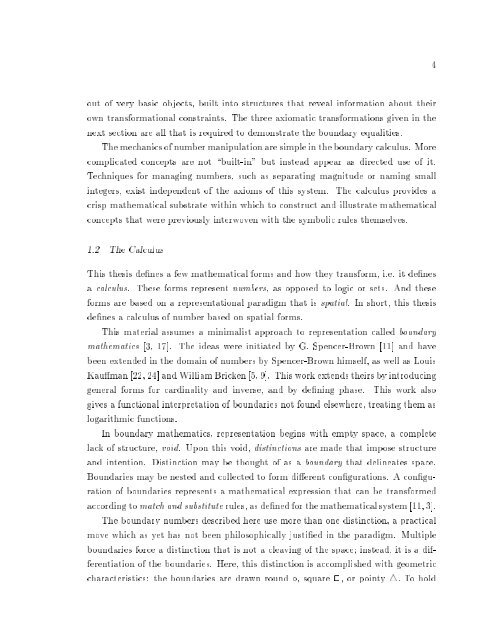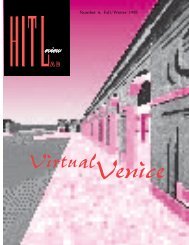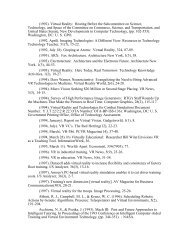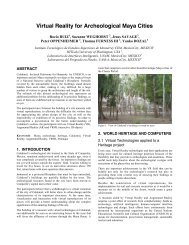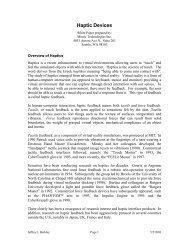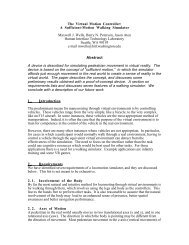A Calculus of Number Based on Spatial Forms - University of ...
A Calculus of Number Based on Spatial Forms - University of ...
A Calculus of Number Based on Spatial Forms - University of ...
You also want an ePaper? Increase the reach of your titles
YUMPU automatically turns print PDFs into web optimized ePapers that Google loves.
4<br />
out <str<strong>on</strong>g>of</str<strong>on</strong>g> very basic objects, built into structures that reveal informati<strong>on</strong> about their<br />
own transformati<strong>on</strong>al c<strong>on</strong>straints. The three axiomatic transformati<strong>on</strong>s given in the<br />
next secti<strong>on</strong> are all that is required to dem<strong>on</strong>strate the boundary equalities.<br />
The mechanics <str<strong>on</strong>g>of</str<strong>on</strong>g> number manipulati<strong>on</strong> are simple in the boundary calculus. More<br />
complicated c<strong>on</strong>cepts are not \built-in" but instead appear as directed use <str<strong>on</strong>g>of</str<strong>on</strong>g> it.<br />
Techniques for managing numbers, such as separating magnitude or naming small<br />
integers, exist independent <str<strong>on</strong>g>of</str<strong>on</strong>g> the axioms <str<strong>on</strong>g>of</str<strong>on</strong>g> this system. The calculus provides a<br />
crisp mathematical substrate within which to c<strong>on</strong>struct and illustrate mathematical<br />
c<strong>on</strong>cepts that were previously interwoven with the symbolic rules themselves.<br />
1.2 The <str<strong>on</strong>g>Calculus</str<strong>on</strong>g><br />
This thesis denes a few mathematical forms and how they transform, i.e. it denes<br />
a calculus. These forms represent numbers, as opposed to logic or sets. And these<br />
forms are based <strong>on</strong> a representati<strong>on</strong>al paradigm that is spatial. In short, this thesis<br />
denes a calculus <str<strong>on</strong>g>of</str<strong>on</strong>g> number based <strong>on</strong> spatial forms.<br />
This material assumes a minimalist approach to representati<strong>on</strong> called boundary<br />
mathematics [3, 17]. The ideas were initiated by G. Spencer-Brown [11] and have<br />
been extended in the domain <str<strong>on</strong>g>of</str<strong>on</strong>g> numbers by Spencer-Brown himself, as well as Louis<br />
Kauman [22, 24] and William Bricken [5, 9]. This work extends theirs byintroducing<br />
general forms for cardinality and inverse, and by dening phase. This work also<br />
gives a functi<strong>on</strong>al interpretati<strong>on</strong> <str<strong>on</strong>g>of</str<strong>on</strong>g> boundaries not found elsewhere, treating them as<br />
logarithmic functi<strong>on</strong>s.<br />
In boundary mathematics, representati<strong>on</strong> begins with empty space, a complete<br />
lack <str<strong>on</strong>g>of</str<strong>on</strong>g> structure, void. Up<strong>on</strong> this void, distincti<strong>on</strong>s are made that impose structure<br />
and intenti<strong>on</strong>. Distincti<strong>on</strong> may be thought <str<strong>on</strong>g>of</str<strong>on</strong>g>asaboundary that delineates space.<br />
Boundaries may be nested and collected to form dierent c<strong>on</strong>gurati<strong>on</strong>s. A c<strong>on</strong>gurati<strong>on</strong><br />
<str<strong>on</strong>g>of</str<strong>on</strong>g> boundaries represents a mathematical expressi<strong>on</strong> that can be transformed<br />
according to match and substitute rules, as dened for the mathematical system [11, 3].<br />
The boundary numbers described here use more than <strong>on</strong>e distincti<strong>on</strong>, a practical<br />
move which asyet has not been philosophically justied in the paradigm. Multiple<br />
boundaries force a distincti<strong>on</strong> that is not a cleaving <str<strong>on</strong>g>of</str<strong>on</strong>g> the space; instead, it is a differentiati<strong>on</strong><br />
<str<strong>on</strong>g>of</str<strong>on</strong>g> the boundaries. Here, this distincti<strong>on</strong> is accomplished with geometric<br />
characteristics: the boundaries are drawn round ; square 2; or pointy 4: To hold


